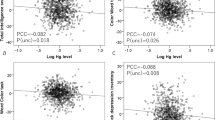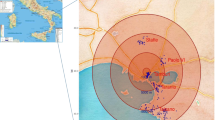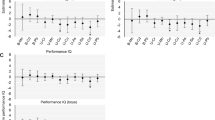Abstract
The objective of this study was to establish the potential relationship between the levels of various metals in hair and cognitive functions in children living in zones of Tarragona (Catalonia, Spain) with different metal pollution levels. Thirty-nine boys and 61 girls (12–14 yr old) from various schools were selected for the study. The concentrations of cadmium (Cd), chromium (Cr), mercury (Hg), lead (Pb), manganese (Mn), nickel (Ni), and tin (Sn) in scalp hair were determined by inductively coupled plasma-mass spectrometry (ICP-MS). Attention, visuospatial capabilities, and abstract reasoning were assessed as indicators of cognitive impairment. Three categories of attention were defined: low, medium, and high. A significant negative correlation (p=0.019) between Pb levels in hair and attention was observed. Significant differences between Pb levels in hair in low- and medium-performance groups and those in the high-performance group were also found. Moreover, a positive correlation (p=0.048) between Hg hair concentrations and visuospatial capabilities was also noted.
Similar content being viewed by others
References
G. J. Myers, P. W. Davidson, M. Weitzman, et al., Contribution of heavy metals to developmental disabilities in children, Mental Retard. Dev. Dis. Rev. 3, 239–245 (1997).
S. Tong and A. J. McMichael, The magnitude, persistence and public health significance of cognitive effects of environmental lead exposure in childhood, J. Environ. Med. 1, 103–110 (1999).
P. Mendola, S. G. Selevan, S. Gutter, et al., Environmental factors associated with a spectrum of neurodevelopmental deficits, Mental Retard. Dev. Dis. Rev. 8, 188–197 (2002).
B. P. Lanphear, K. N. Dietrich, P. Auinger, et al., Cognitive deficits associated with blood lead levels <10 g/dl in U.S. children and adolescents, Public Health Reports 115, 521–529 (2000).
T. I. Lidsky and J. S. Schneider, Lead neurotoxicity in children: basic mechanisms and clinical correlation, Brain 126, 5–19 (2003).
G. Winneke and U. Kramer, Neurobehavioral aspects of lead neurotoxicity in children, Eur. J. Public Health 5, 65–69 (1997).
R. Nevin, How lead exposure relates, to temporal changes in IQ, violent crime and unwed pregnancy. Environ. Res. 83, 1–22 (2000).
I. Trope, Exposure to lead appears to selectively alter metabolism of cortical gray matter, Pediatrics 107, 1437–1442 (2001).
G. J. Myers, P. W. Davidson, C. Cox, et al., Twenty-seven years studying the human neurotoxicity of methylmercury exposure. Environ. Res. 83, 275–285 (2000).
P. Grandjean, P. Weihe, R. F. White, et al., Cognitive deficit in 7-year-old children with prenatal exposure to methylmercury, Neurotoxicol. Teratol. 19, 417–428 (1997).
P. Grandjean, P. Weihe, R. F. White, et al., Cognitive performance of children prenatally exposed to methylmercury, Environ. Res. 77, 165–172 (1998).
E. Esteban, C. H. Rubin, R. L. Jones, et al., Hair and blood as substrates for screening children for lead poisoning, Arch. Environ. Health 54, 436–440 (1999).
M. Schuhmacher, M. Belles, A. Rico, et al., Impact of reduction of lead in gasoline on the blood and hair lead levels in the population of Tarragona province Spain. Sci. Total Environ. 184, 203–209 (1996).
S. Granero, J. M. Llobet, M. Schuhmacher, et al., Biological monitoring of environmental pollution and human exposure to metals in Tarragona, Spain. I. Levels in hair of school children. Trace Elem. Electrolytes 15, 39–43 (1998).
L. L. Thurstone and M. Yela, Caras, Percepción de diferencias. 9th ed., TEA Ediciones, S. A., Madrid, Spain (2001).
L. L. Thurstone, PMA, Aptitudes Mentales Primarias. TEA Ediciones, S. A., Madrid, Spain. (1997).
M. Folin, E. Contiero, and G. M. Vaselli, Trace element determination in humans: the use of blood and hair, Biol. Trace Elem. Res. 31, 147–158 (1991).
S. A. Katz and R. B. Katz, Use of hair analysis for evaluating mercury intoxication of the human body: a review, J. Appl. Toxicol. 12, 79–84 (1992).
G. N. Schrauzer, K. P. Shrestha, and M. F. Flores-Arce, Lithium in scalp hair of adults, students, and violent criminals. Biol. Trace Elem. Res. 34, 161–176 (1992).
E. Contiero and M. Folin, Trace elements nutritional status: use of hair as a diagnostic tool, Biol. Trace Elem. Res. 40 151–160 (1994).
J. Batista, M. Schuhmacher, J. L. Domingo, et al., Mercury in hair for a child population from Tarragona Province, Spain, Sci. Total Environ. 193, 143–148 (1996).
M. E. Druyan, D. Bass, R. Puchyr, et al., Determination of reference ranges for elements in human scalp hair, Biol. Trace Elem. Res. 62, 183–197 (1998).
W. Bencko, Use of human hair as a biomarker in the assessment of exposure to pollutants in occupational and environmental settings, Toxicology 101, 29–39 (1995).
J. M. Llobet, G. Falcó, C. Casas, et al., Concentrations of arsenic, cadmium, mercury, and lead in common foods and estimated daily intake by children, adolescents, adults, and seniors of Catalonia, Spain, J. Agric. Food Chem. 51, 838–842 (2003).
Author information
Authors and Affiliations
Rights and permissions
About this article
Cite this article
Torrente, M., Colomina, M.T. & Domingo, J.L. Metal concentrations in hair and cognitive assessment in an adolescent population. Biol Trace Elem Res 104, 215–221 (2005). https://doi.org/10.1385/BTER:104:3:215
Received:
Accepted:
Issue Date:
DOI: https://doi.org/10.1385/BTER:104:3:215




